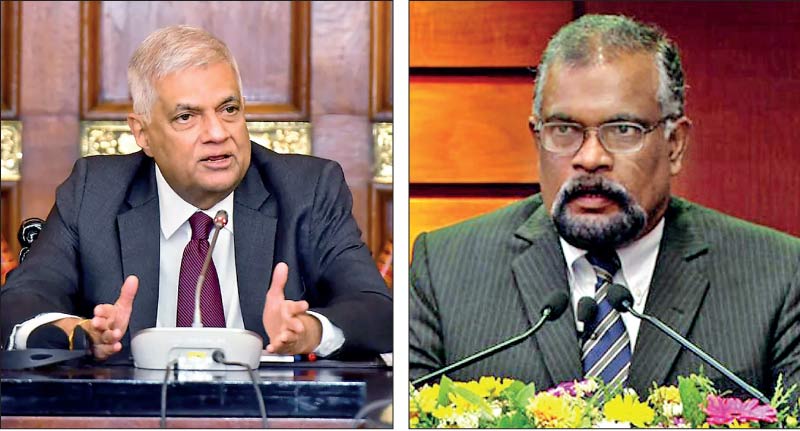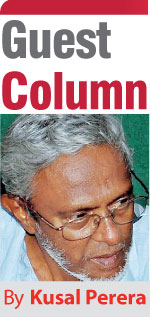Saturday Apr 26, 2025
Saturday Apr 26, 2025
Friday, 5 July 2024 00:00 - - {{hitsCtrl.values.hits}}

SL people have been left totally out of the whole process of “debt restructuring” and in the dark on “conditions and measures” the Wickremesinghe Government has agreed to
|
 Sri Lanka signing agreements with bi-lateral lenders Japan, China and India to restructure external debts has received calculated praise from SJB leadership and from the IMF with expectations. Japan congratulated Sri Lanka for effectively “managing debt obligations”.
Sri Lanka signing agreements with bi-lateral lenders Japan, China and India to restructure external debts has received calculated praise from SJB leadership and from the IMF with expectations. Japan congratulated Sri Lanka for effectively “managing debt obligations”.
Endorsements, praises and congratulations apart, SL people have been left totally out of the whole process of “debt restructuring” and in the dark on “conditions and measures” the Wickremesinghe Government has agreed to. People do not know what “debt sustainability” in fact is. Finance Ministry explanations on the “external debt relief deal” is everything but repayment of debts. “This has important implications for supporting economic growth as foreign-funded capital expenditure can resume. This would have material implications for the construction sector in particular, along with the positive spill-over effects for the rest of the economy.” (Daily FT – 29 June, 2024)
It only means, we can resume borrowing yet again in a global trade economy strung with many geo-political factors. With more borrowing possible, construction sector, a major external debt creator with massive fraud and corruption during pre-bankruptcy period will stand to gain. Spill-overs if any are not solutions to social issues. This is not about economic stability and recovery for the whole society. This is about getting further entrenched in global trade with geo-political demands. One major reason there is no transparency in any of the transactions President Wickremesinghe entered into with the IMF and in debt restructuring, is untold geo-political tie-ups. I doubt the President would ever be transparent and accountable to the people with numerous geo-political obligations that would have to remain out of public eye. But people have a right to know the conditions they are tied to in “deferring bi-lateral loan instalment payments”.
The social impact of the economic crisis that was “peoplised” with a covert leadership at Galle Face as #GotaGoHome, but proudly spoken of as “leaderless” was what manipulated RW to reach the presidency. First sworn in as PM on 12 May evening, he had no choice but to solve the petrol-diesel shortage that led to power cuts as well. Sections of the Colombo middleclass want people to accept, RW did solve the immediate crisis with his amazing management ability in bringing “economic stability.”
Amazing management ability
What was this amazing management ability? On WB data, in 2021 Sri Lanka has imported fuel mainly from UAE, India, Singapore, Malaysia and South Africa. For SL to go dry on fuel from beginning of 04/Q 2021, either these countries have refused fuel to SL on credit or, for untold reasons SL authorities have not imported adequate supplies in advance for the 4/Q of 2021 and for the first half of year 2022. Then came Central Bank’s declaration in early April 2022 it would not honour foreign debt payments amidst mass protests in Galle Face Green that unanimously decided President Gotabaya Rajapaksa has failed and demanded his immediate resignation.
PM Rajapaksa was forced out of office and his official residence on 9 May, almost a month after the bankruptcy declaration by the CBSL Governor. RW a lone MP from the UNP national list was sworn in as PM three days later, while protests continued to demand the ouster of President Gotabaya Rajapaksa. That political chaos left no chance for anyone to negotiate for fuel imports on credit from even alternate sources.
Sworn in as PM, what did Wickremesinghe do in just a month or two to have fuel stations pump petrol without queues? Did petroleum exporters believe a lone MP installed as PM with no proper government, could provide payments for supply of fuel?
RW had not been proven a successful PM any time before. As head of elected government in 2001 December, RW was a total failure, unable to manage the Government even for three whole years. Made the PM once again in 2015 January with no majority in Parliament and leaning on Maithripala Sirisena’s electoral victory as President to form a coalesced majority government at the 2015 August elections, Wickremesinghe as PM was again proved a failure. With an IMF funded program to establish a sustainable economy since June 2016, RW as head of government left SL with a larger forex deficit in November 2019 than what he began with in January 2015.
Forbes reporting on the deteriorating economy said, “…But this doesn’t necessarily mean that Sri Lanka’s current administration is doing much better. Under President Maithripala Sirisena and Prime Minister Ranil Wickremesinghe, who came to office at the beginning of 2015, domestic debt grew by 12% and external debt by 25% without starting any new large-scale infrastructure projects” (30 September 2016). In real terms, external debt that was $ 43.9 billion in 2015, increased to $ 56.1 billion by end 2019 under PM Wickremesinghe, though supported by the IMF extended fund facility. That sums up Wickremesinghe’s rhetoric and capability.
The difference in Wickremesinghe three years later
What then could be the difference in Wickremesinghe three years later in 2022? “The issue has been petrol … and that will take a bit of time. We are hoping to get shipment of petrol by July 22 but I have asked the [concerned] minister to try to get the shipment earlier” PM Wickremesinghe was quoted by Al Jazeera on 6 July 2022, hardly two months into Premiership. Any magic there? Or was there a manipulator behind scenes RW had confidence in, he would be taken care of? One who created and prepared a robust anti-Rajapaksa mindset among urbans in advance to bring RW to the helm? Apart from “conspiracy theories” quite common now, there are enough historical evidence on external political intruders that created local opinion to bring out mass protests in manipulating political power in sovereign nation States, for two main reasons. One is heavy economic interests and the other is geo-political dominance for economic and State security advantage.
Sri Lanka is geographically the most sensitively located nation in the Indian Ocean to have lived through such manipulations even before. As one quote below indicates, 2015 elections seem to have had such external fingering. This political sensitivity is clearly articulated in the opening paragraph itself in the “Integrated country strategy – Sri Lanka” report, edited and approved for public release by the US State Department. It says with carefully phrased diplomacy, “Positioned at the geographic and political heart of the Indian Ocean, Sri Lanka is the epicenter of the 21st century struggle for regional influence… Sri Lanka is arguably the most strategically located maritime nation in the region. More than 60,000 ships – including two-thirds of the world’s seaborne crude oil, half of its container ships, and all U.S. Navy vessels passing between the 5th and 7th Fleets – annually transit Sri Lankan waters.” One important factor is US naval vessels go through SL waters.
“Mission Goal 1” in this same document says, “Advance a free, open, and secure Indo-Pacific region that promotes American security interests by increasing Sri Lanka’s capacity to protect its sovereignty.” In justifying Objective No.1.2, the document says, “…Following the 2015 Sri Lankan election, the United States increased its military engagement with the armed forces, particularly the Navy”. There were other reasons and objectives too to “promote American security interests” including business interests as well.
A close comparative in post WW II history is regime change carried out in Chile ousting elected President Salvador Allende in 1973. “The Central Intelligence Agency secretly financed striking labor unions and trade groups in Chile for more than 18 months before President Salvador Allende Gossens was overthrown, intelligence sources revealed today” wrote New York Times on 20 September 1974. It also says, and this is comparatively quite important. “Among those heavily subsidized, the sources said, were the organizers of a nationwide truck strike that lasted 26 days in the fall of 1972, seriously disrupting Chile’s economy and provoking the first of a series of labor crises for President Allende.” Then it added, “At its peak, the 1973 strikes involved more than 250,000 truck drivers, shopkeepers and professionals who banded together in a middle‐class movement that, many analysts have concluded, made a violent overthrow inevitable.” (https://www.nytimes.com/1974/09/20/archives/cia-is-linked-to-strikes-in-chile-that-beset-allende-intelligence.html)
After the coup, after Allende was deposed with murder, reported in some media as suicide, there were official denials about US funding the strike movement. “After the coup, the State Department formally denied any financial involvement in the 1973 truck strike or the other work stoppages and protests in Chile, declaring that such suggestions are absurd” wrote New York Times. What is also important to note is the fact, with General Augusto Pinochet’s violent take-over, all strikes, work stoppages and protests in Santiago and in other cities, simply evaporated with the middleclass going back to their homes.
Anymore comparisons? Yes, immediately after the brutal regime change, the IMF moved in to work with the “Chicago Boys”, the economic consultant group appointed by General Pinochet. A year later in end 1974, the IMF approved a soft loan of $ 79 million. During the second half of the decade of 70, high inflation was controlled and the Chilean budget was reduced with heavy cuts on public spending. Decade of 80 saw increasing inflation and poverty reaching 40%. Chile came under stricter IMF dictates. More free market reforms were brought with more IMF loans and heavy suppression of dissent and protests.
Comparisons thus show urban protests, violent regime change, a new repressive regime installed, IMF entry and its dictates, with serious doubts on actual recovery for the whole country. Post WW II global politics prove IMF and national economies cannot be discussed in their abstract forms.
Discover Kapruka, the leading online shopping platform in Sri Lanka, where you can conveniently send Gifts and Flowers to your loved ones for any event including Valentine ’s Day. Explore a wide range of popular Shopping Categories on Kapruka, including Toys, Groceries, Electronics, Birthday Cakes, Fruits, Chocolates, Flower Bouquets, Clothing, Watches, Lingerie, Gift Sets and Jewellery. Also if you’re interested in selling with Kapruka, Partner Central by Kapruka is the best solution to start with. Moreover, through Kapruka Global Shop, you can also enjoy the convenience of purchasing products from renowned platforms like Amazon and eBay and have them delivered to Sri Lanka.
Discover Kapruka, the leading online shopping platform in Sri Lanka, where you can conveniently send Gifts and Flowers to your loved ones for any event including Valentine ’s Day. Explore a wide range of popular Shopping Categories on Kapruka, including Toys, Groceries, Electronics, Birthday Cakes, Fruits, Chocolates, Flower Bouquets, Clothing, Watches, Lingerie, Gift Sets and Jewellery. Also if you’re interested in selling with Kapruka, Partner Central by Kapruka is the best solution to start with. Moreover, through Kapruka Global Shop, you can also enjoy the convenience of purchasing products from renowned platforms like Amazon and eBay and have them delivered to Sri Lanka.